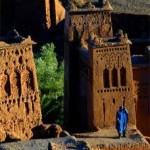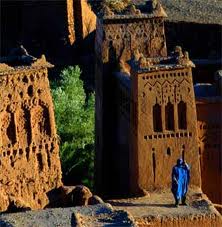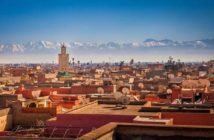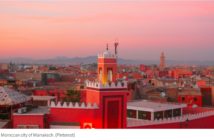The Independent
By HAZEL SOUTHAM
 At the picturesque stopping point of Tizi-n-Toudat in Morocco’s High Atlas Mountains, two hundred goats, 11 camels, 30 sheep and three donkeys graze along the steep slopes. In the nearby camp, tents are being erected for cooking and dining. Wood is being gathered. Mint tea is being brewed. And quietly, beyond the stream, one of the sheep is meeting its end to provide tonight’s dinner.
At the picturesque stopping point of Tizi-n-Toudat in Morocco’s High Atlas Mountains, two hundred goats, 11 camels, 30 sheep and three donkeys graze along the steep slopes. In the nearby camp, tents are being erected for cooking and dining. Wood is being gathered. Mint tea is being brewed. And quietly, beyond the stream, one of the sheep is meeting its end to provide tonight’s dinner.
This is a scene from the bi-annual migration of Morocco’s nomadic Berber people, and the Elyakoubi family, whose livestock pepper the landscape, is following a route trodden by their ancestors for 4,000 years.
The reason for their migration is simple: the Berbers take their animals to the best grazing areas year-round. In winter, they traditionally roam on the mountains’ lower slopes where temperatures are warmer, and during the summer, they head up to the cooler plateaux, fleeing the heat in the aim of finding fresh pasture.
There is nothing arbitrary about the migration – the routes, stopping points and best places for grazing have been passed on down the generations. But this year, the Elyakoubi family trudge the route with heavy hearts, troubled by the thought that they will be some of the last to do so.
A crescent moon rises above the mountains in the late dusk as Izza Elyakoubi, 25, and her cousin Said, 15, bring the goats and sheep down from the slopes for the night. They herd them into a circular stone corral, where they will also sleep, at a height of 8,720ft above sea level.
Bringing them in late, Said says, means there’s more chance of getting some rest at night – hungry sheep wander off, but those with full stomachs stay put. As they get little more than an hour’s sleep per night during the migration, the family do everything they can to ensure those few extra minutes of rest.
Said has been shepherding for three years and has never been to school. He will be the first generation of his family to live a life outside nomadism. “I would like to do something else,” he says, over a glass of mint tea. “I’d like to be a farmer and grow barley and almonds, figs and vegetables.
“It’s getting difficult to live like this. It’s getting tougher every year. We need to buy in straw and barley for our animals, which we never had to do in the past. It’s the third year we’ve had to do that, because there’s not been enough rainfall. I’d feel bad about settling in a village, but I’d get over it. I’m more scared of working in this life until I’m old.”
A mix of climate change and deforestation means that there is now less water and grazing for the herders. They have stopped here at Tizi-n-Toudat not because it’s a pleasure to soak their tired feet in the mountain stream, but because it’s one of only three places to water the animals on the six-day, 60 km journey.
Just 30 years ago, things were very different. Much of the lower slopes were forested, largely with juniper trees. Barbary sheep (a goat-antelope creature with considerable horns) roamed the woodlands, as did wolves. “It was beautiful,” recalls Baichou Elouardi, a former nomad who now cooks for tourists on the migration.
“In the past there were trees, there was rain and if there was nothing to eat on the ground, the camels and goats could eat the juniper leaves. So they could keep going,” he says. “Now when you have a bad year of weather you have to buy feed. This is the end of life for us.”
The group walks for five days before seeing a lone juniper tree on the mountainside. The rest, we are told, have been cut down for fuel and building.
The nomads’ problems are compounded by the forecasts of a World Bank report published in 2009, which predicts further significant changes in weather patterns. By 2050, rainfall in Morocco may be reduced by 20 per cent, with a 40 per cent drop possible by 2080.
The Berber people are tough and resourceful, but this mix of climate change and deforestation has taken its toll. In 1988, some 410 families made the bi-annual migration. Today, there are just 15 families, including the Elyakoubis.
Only tourism works towards maintaining this vanishing way of life, according to Mohamed, 32, the head of the Elyakoubi family. After this year’s cold, wet winter killed half his new-born goats, he took the decision to bring tourists on the migration to help feed his family. “If there are good years [for rainfall] and there are lots of tourists, we can keep going,” he says. “But with no grass, tourism is not enough.”
Tonight Said, Izza and Baichou dine on kebabs cooked over an open fire, lamb tagine, rice, salad and finally, slices of melon, washed down with verbena tea from tiny glasses. But they would not have such a meal without tourists. Though surrounded by sheep and goats, meat is seldom on the menu, and their usual diet consists mainly of tea, bread, oil and couscous.
The need to get to good grazing areas dictates the migration’s route. Another family, also camped at Tizi-n-Toudat, is hosting a small group of German tourists. The British tourists with the Elyakoubis are instructed to rise at 6am the following morning to ‘beat the Germans’.
Initially they laugh, thinking this is a joke about their countries’ old historic rivalry. But the command is not to entertain the tourists. If the Elyakoubi family are not the first to arrive at their next stop, they won’t get the pick of the grazing or camping positions.
The terrain the nomads cover is tough. At best they follow narrow sheep paths. At worst they climb over boulders for five-and-a-half hours, in a literal uphill struggle. “I spend all day throwing stones at the sheep to guide them,” says Said and Mohamed’s mother Aisha, 46. “My arm aches. [The tourists] may like this way of life, but for us, it’s difficult.”
Said, Izza, Aisha and Mohamed arrive at the Oulmzi Plateau, their home for the summer. The trek downhill to the village of Ait Ouham is a vision of what the mountains were like three decades ago. Juniper trees line the route and in the village itself, irrigation channels water cherry, plum, walnut and apple orchards.
Mint, turnips, potatoes and spring onions grow amid vividly green terraces of barley, wheat and oats. Thyme, euphorbia and poppies grow by the pathway. “At that time it was not a difficult life,” says Aisha Ouaziz, a 69 year-old former nomad who now lives in the village. ‘There was grass, milk and butter and lots of goats and sheep.”
“The mountains gave us enough to eat,” she says. “We worked hard and ate well. Now, we don’t want to be nomadic. It’s not a good life anymore.”
RECENTLY READ
A new social reading experience from The Independent, powered by Facebook. Learn More.
The Independent
2 Derry Street London W8 5TT
© independent.co.uk







